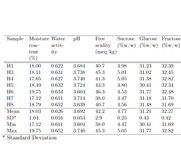Physicochemical and microbiological characterization of Apis mellifera sp. honey from Southwest of Antioquia in Colombia
Main Article Content
Keywords
honey, characterization, physicochemical parameters, microbiology analysis, quality standards
Abstract
Characterizations of Apis mellifera honey produced in Southwest of Antioquia, an important coffee region of Colombia, have not been published in recent years. In the present work, seven samples of honey collected in the mentioned region, were physically (refractive index, specific rotation, density), chemically (moisture content, water activity, pH, free acidity, carbohydrates) and microbiologically (Clostridium, fungi and yeast) analyzed. The results show that the analyzed honeys meet both national (Resolución 1057 of 2010) and International (Codex-Stan 12 of 1981) standards for moisture content, free acidity, sucrose content and microbiological parameters, indicating their good quality. Fructose/glucose ratio, pH and specific rotation values indicate that the samples are blossom honeys.
Downloads
References
[2] Codex Alimentarius Commission, “Revised Codex Standard for Honey Codex Stan 12-1981, Rev. 1 (1987), Rev. 2 (2001),” Codex Standard, pp. 1–7, 1981.
[3] E. Anklam, “A review of the analytical methods to determine the geographical and botanical origin of honey,” Food Chemistry, vol. 63, no. 4, pp. 549–562, 1998.
[4] M. S. Finola, M. C. Lasagno, and J. M. Marioli, “Microbiological and chemical characterization of honeys from central Argentina,” Food Chemistry, vol. 100, no. 4, pp. 1649–1653, 2007.
[5] J. A. Snowdon and D. O. Cliver, “Microorganisms in honey,” International Journal of Food Microbiology, vol. 31, no. 31, pp. 1–26, 1996.
[6] S. Bogdanov, E. Forschungsanstalt fur Milchwirtschaft, and I. H. Commission., Honey quality : methods of analysis and international regulatory standards : review of the work of the International Honey Commission. Bern: Federal Dairy Research Institute Liebefeld, 1999.
[7] L. D. Rodríguez, “Informe de la actividad apícola en Antioquia,” Centro de Desarrollo Rural Créame, Medellín, Antioquia, Tech. Rep., 2009.
[8] A. M. Cifuentes and G. L. García, “Evaluación de la calidad de miel de abejas procedente de la zona cafetera del Suroeste antioqueño,” Ph.D. dissertation, Universidad Nacional de Colombia Sede Medellín, 1987.
[9] H. D. Chataway, “The determination of moisture in honey,” Can. J. Res. Canadian Journal of Research, vol. 6, no. 5, pp. 532–547, 1932.
[10] S. Bogdanov, P. Martin, and C. Luellmann, “Harmonised methods of the European Honey Commission,” APIDOLOGIE, vol. 28 SUPP/1, p. ALL, 1997.
[11] G. Downey, K. Hussey, J. D. Kelly, T. F. Walshe, and P. G. Martin, “Preliminary contribution to the characterisation of artisanal honey produced on the island of Ireland by palynological and physico-chemical data,” Food Chemistry, vol. 91, no. 2, pp. 347–354, 2005.
[12] L. S. M. Costa, M. L. S. Albuquerque, L. C. Trugo, L. M. C. Quinteiro, O. M. Barth, M. Ribeiro, and C. A. B. D. Maria, “Determination of non-volatile compounds of different botanical origin Brazilian honeys,” Food Chemistry, vol. 65, no. 3, pp. 347–352, 1999.
[13] M. C. Zamora, J. Chirife, and D. Roldán, “On the nature of the relationship between water activity and % moisture in honey,” Food Control, vol. 17, no. 8, pp. 642–647, 2006.
[14] R. A. Gleiter, H. Horn, and H.-D. Isengard, “Influence of type and state of crystallisation on the water activity of honey,” Food Chemistry, vol. 96, no. 3, pp. 441–445, 2006.
[15] Salamanca G. G., F. C. Pérez, and B. J. A. Serra, “Determinación de la actividad de agua en mieles colombianos de las zonas de Boyacá y Tolima,” Apicervices - Galería Apícola Virtual., 2001. [Online]. Available: http://www.apiservices.com/articulos/salamanca/actividad_agua.htm
[16] S. Bogdanov, Book of Honey (Online version), 1st ed. Switzerland: Bee Research Center, 2009. [Online]. Available: http://www.bee-hexagon.net/en/protected-sid-NFBoeXNpY2FsUHJvcGVydGllc0hvbmV5LnBkZg%3D %3D.htm
[17] J. W. W. Jr., “Honey,” in Food Research, ser. Advances in Food Research, C. O. Chichester, Ed. Academic Press, 1978, vol. 24, pp. 287–374.
[18] A. C. Soria, M. González, C. de Lorenzo, I. Martínez-Castro, and J. Sanz, “Characterization of artisanal honeys from Madrid (Central Spain) on the basis of their melissopalynological, physicochemical and volatile composition data,” Food Chemistry, vol. 85, no. 1, pp. 121–130, 2004.
[19] P. Vit, S. Bogdanov, and V. Kilchenmann, “Composition of Venezuelan honeys from stingless bees (Apidae: Meliponinae) and Apis mellifera L,” Apidologie Apidologie, vol. 25, no. 3, pp. 278–288, 1994.
[20] M. M. Cavia, M. A. Fernández-Muiño, E. Gómez-Alonso, M. J. Montes-Pérez, J. F. Huidobro, and M. T. Sancho, “Evolution of fructose and glucose in honey over one year: influence of induced granulation,” Food Chemistry, vol. 78, no. 2, pp. 157–161, 2002.
[21] I. Manikis and A. Thrasivoulou, “La relación entra las características físicoquímicas de la miel y los parámetros de sensibilidad a la cristalización,” Apiacta, pp. 106–112, 2001.
[22] V. Nanda, B. C. Sarkar, H. K. Sharma, and A. S. Bawa, “Physico-chemical properties and estimation of mineral content in honey produced from different plants in Northern India,” Journal of Food Composition and Analysis, vol. 16, no. 5, pp. 613–619, 2003.

